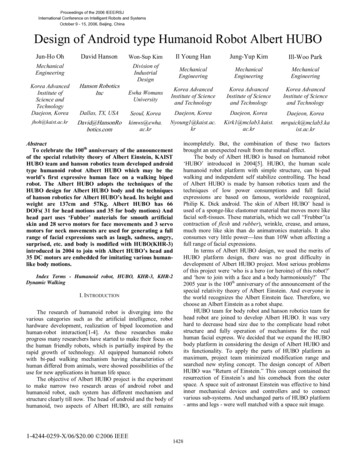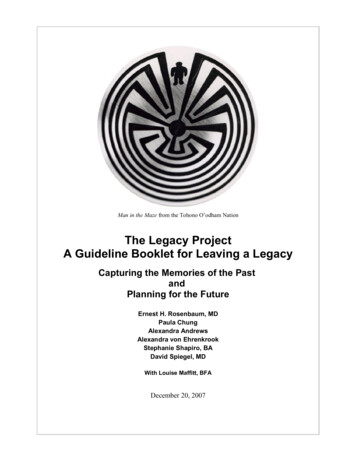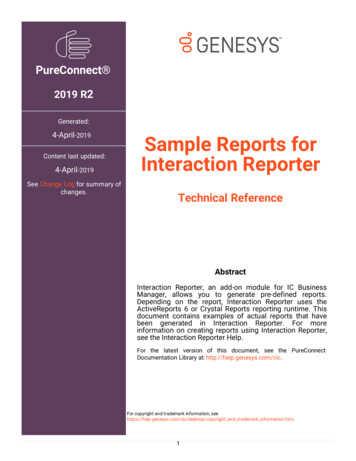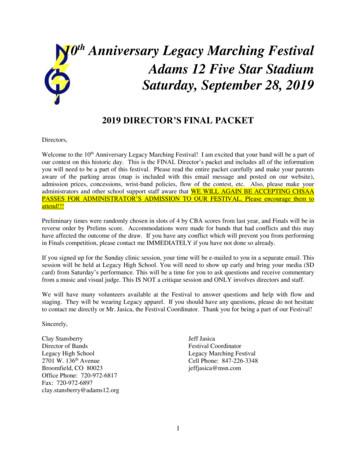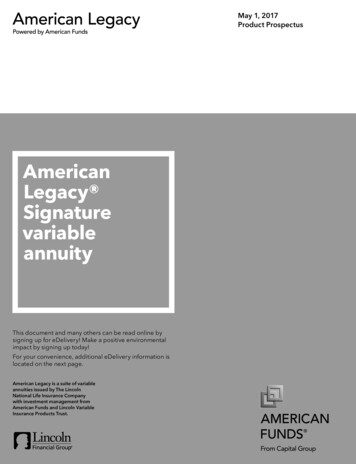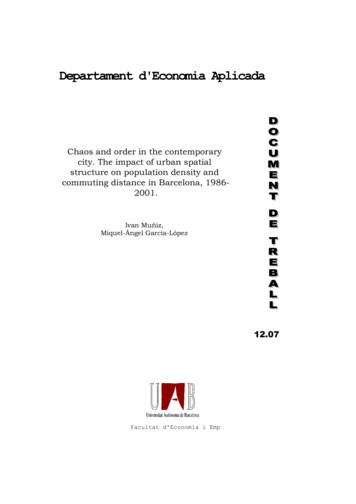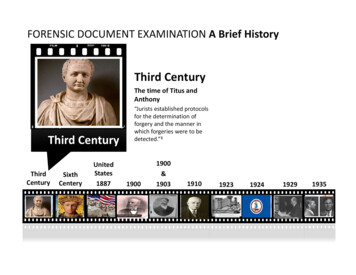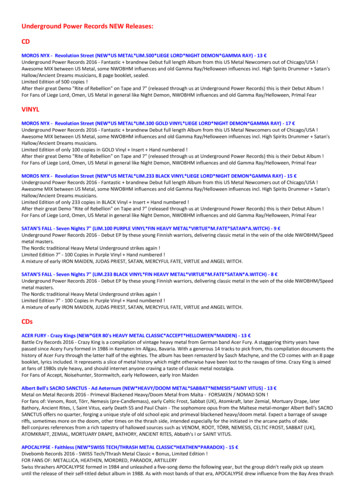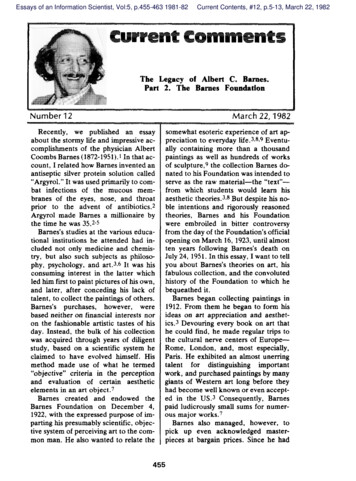
Transcription
Essays of an Information Scientist, Vol:5, p.455-463 1981-82Current Contents, #12, p.5-13, March 22, 1982The Legacy of Albert C. Banes.Pact 2. The Barnes FoundationNumber12MarchRecently,we publishedan essayabout the stormy liie and impressive accomplishmentsof the physician AlbertCoombs Barnes ( 1872- 1951 ).1 In that account, I related how Barnes invented anantiseptic silver protein solution called“Argyrol.” It was used primarily to combat infectionsof the mucous membranes of the eyes, nose, and throatprior to the advent of antibiotics.zArgyrol made Barnes a millionaire bythe time he was 35.2-5Barnes’s studies at the various educational institutions he attended had included not only medicine and chemistry, but also such subjects as philosophy, psychology, and art .3.6 It was hisconsuming interest in the latter whichled him fmt to paint pictures of his own,and later, after conceding his lack oftalent, to collect the paintings of others.Barnes’spurchases,however,werebased neither on financial interests noron the fashionable artistic tastes of hisday. Instead, the bulk of his collectionwas acquired through years of d lgentstudy, based on a scientflcsystem heclaimed to have evolved hmself.Hismethod made use of what he termed“objective”criteria in the perceptionand evaluationof certainaestheticelements in an art object. TBarnes createdand endowedtheBarnes Foundationon December4,1922, with the expressed purpose of imparting his presumably scienttlc, objective system of perceiving art to the common man. He also wanted to relate the45522,1982somewhat esoteric experience of art appreciation to everyday liie.3.B,9 Eventually containing more than a thousandpaintings as well as hundreds of worksof sculpture, g the collection Barnes donated to hk Foundation was intended toserve as the raw material-the“text”from which students would learn hisaesthetic theones.s,s But despite his noble intentions and rigorously reasonedtheories,Barnes and his Foundationwere embroiledin bitter controversyfrom the day of the Foundation’s officialopening on March 16, 1923, until ahnostten years following Barnes’s death onJuly 24, 1951. In this essay, I want to tellyou about Barnes’s theories on art, hisfabulous collection, and the convolutedhktory of the Foundationto which hebequeathed it.Barnes began collecting paintings in1912. From them he began to form hisideas on art appreciationand aesthetics,3 Devouring every book on art thathe could find, he made regular trips tothe cultural nerve centers of Europe—Rome, London, and, most especially,Paris. He exhibited an almost unerringtalentfordktinguishingimportantwork, and purchased paintings by manygiants of Western art long before theyhad become well known or even accepted in the US.3 Consequently,Barnespaid ludicrously small sums for numerous major works. TBarnes also managed,however,topick up even acknowledgedmasterpieces at bargain prices. Since he had
shrewdly sold his Argyrol business forsix million dollars prior to the stockmarket crash of 1929, he remained quitewealthy during the worldwide depression of the 1930s. Few of the formerlywealthy families and businessesthatwere forced to sell their treasured artwere in a position to quibble over whatever price Barnes cared to offer. 10 Infact, Barnes had a wide reputation forunabashed ruthlessness in the pursuit ofcuriously,he wanted.a paintingthough, he was reluctant throughout hislife to discuss purchase prices. To aquestion about whether or not it wastrue that he had paid the highest priceever for a painting by a particular artist,and whether or not he still had thepaintingin his possession,Barnesresponded:“The equivalent of askingme to confirm such rumors would beasking a lady if the rumor were true thatshe had bought the most expensive pairof panties ever sold by Lit’s [a Philadelphia department store] and if she is stillwearing them. ”dBarnes’s theories on art appreciationand education derive partly from thethoughtsof AmericaneducatorandphilosopherJohn Dewey. Dewey wasconvinced that philosophy was of valueonly when it dealt with the affairs ofeveryday life and could be used as aguide in intelligently conducting thoseaffairs. Similarly, Barnes believed thatart should not be divorced from everyday life and the “real” world. Accordingto Barnes, art is not merely a hobby towhich one may turn in one’s spare time,nor a luxury to be indulged in in thename of “culture, ” nor a relic to be approached in a spirit of worship. Instead,art is a vital part of every person’s workaday world, affecting each of us incountlessways,largeandsmall,whether we know it or not. 11The roison d’ tre of the Foundation’seducationalprogram is to remove artfrom its customarily detached, esotericniche and link it with life itself. 11 Yet,despite his crusading desire to bring art456to me common people, Barnes was convinced that it is presumptuous of the uninitiated to venture any opinions on art,and that it is useless for the untrained toview art.lz At the same time, he believed that it is vital to a true understanding and appreciationof paintingfor a student to have direct contact withthe paintings themselves. Barnes’s educationalphilosophyis perhapsbestsummed up by the following statementfrom a World War II-vintage pamphlet:“Art appreciationcan no more be absorbed by aimless wandering in galleriesthan can surgery be learned by casualvisits to a hospital. ”sFor Barnes, no system for analyzingan objet dart was adequate, other thanhis own. According to his theory of aesthetics as set forth in his book, The A rtin Painting, appreciating art is difficultprimarily because of the unconscioushabits and preconceptionsabsorbedfrom a society “which is but little interested in art. “ 12 The function of a painting, in spite of what most of us may havebeen led to believe, is not to photographically reproduce the subject matter nor to tell a story. Instead, a paintingshould “reveal to us the qualities in objects and situations which are significant, which have the power to move usesthetically.The artist must open oureyes to what, unaided, we could notsee . . . . A landscape . . .should catch thespirit of the scene; a portrait . .what isessentialorcharacteristicof thesitter.”lzThus, the artist’s goal is to help theviewer see as he himself sees. But theonly resources that a painter may legitimately employ to that end are the elements of color, light, line, and mass—the “language” of art. The success of theartist’s efforts may be judged by hiscommand of thk language—thatis, bythe interplay of these four elements, andhow well they achieve the effect the artist intended. A true artist, according toBarnes, does not stoop to depend uponhis viewer’s resources, or upon familiar
devices or symbols to do his work forhim. If he wants to inspire in a viewer asense of tragedy, for instance, he doesnot paint a picture of some tragic scene.Instead, he may use somber colors, constrictedspaces,and thin, waveringlines—or harsh colors, chaotic spaces,and bold, shrieking lines-dependingupon how he himself experiencestheemotions of grief and tragedy. Thus heseeks to instill in the viewer some ideaof how one other human being (the artist) experiences an emotion felt, at onetime or another, by all. The viewer gainsan insight into human experience thatcould not otherwisehave been absorbed.And if representationalandnatural shapes, colors, and spatial relationships cannot be made to serve theartist’s purposes, then not only is it permissible for him to distort them untilthey do, it is incumbent upon Km to doso,Barnes’s criteria for analyzing a painting formed the cornerstoneof severalother works besides The Art in Painting.These include Art and Education, 13 TheFrench Pn”mitives and Their Forms, 14The Art of Henri Matisse, 15 The Art ofRenoir, lb and The Art of C&zanne, 17The art world’s opinion of these effortsseems to have been ahnost equaflydivided betweenadmirationl&22and5c01n.026 k a 1939 review of The Artof C&zanne, for instance, Art Digestrecommendedthat the book be “readand re-read, ”2I and the BrooklynMuseum Quarterly cafled the book a“penetratingstudy of the structure ofC6zanne’s art.”zz Yet a 1939 review thatappearedin Parnassus roundly criticized Barnes for “pretensions to a scienttilc method,” “dogged and dull determination in the pursuit of [that] defective method,” and a “superficial,” ofteninaccurate, account of historical fact. A review in the Magazine of Art agreed,calfing The Art of G4zanne “dull, long-winded and. .repetitious, ” and notedthat “the only scientific standards successfully applied to paintings are those457actueveaDy tne t’c3CeIttly developedX-ray and chemical color tests, “2SToday, both art and art criticism arerecognizedas highly subjective fieldsthat are not amenable to rigid ideas andrigorous methods. According to art historian Horst W. JanSon, New York University, “Barnes’s method is no morescientific than any other method. It isnot necessarily a bad thing to judge artby formal values alone, as Barnes did; itis simply one-sided .“27 Janson also notesthat Barnes’s ideas dld not really originate with Barnes-hesimply took theideas of earlier scholars and critics, putthem into his own words, and seemed tobelieve that he had invented somethmgnew. Thus, although formal analysis ofthe language of art plays a large part incontemporaryart criticism,Barnes isnot credited with having fathered themethod. Indeed, his books and theoriesare largely ignored today. What he isadmired for, essentially, is his pioneering taste. Janson acknowledged that theBarnes Foundation possesses a staggering collection of important works thatwere gathered at a time when the artistswho painted them were decidedly unpopular.27While the fire has long since gone outof the controversy surrounding Barnes’sideas on art, the enmity between Barnesand the art communityat one timeburned fiercely. On Barnes’s part, thefeud was precipitated by the reception aportion of his beloved collectionreceived from the art establishmentandthe general public in 1923, during an exhibition at the PennsylvaniaAcademyof Fhte Arts in Philadelphia. 3 Barneswas fresh from a well-received exhibition of 75 of his latest acqui.dtions,staged by art dealer Paul Gui12aume inParis. Consequently, he accepted the invitation of the Academy when it proposed to sponsor a stillar exhibition inthe US, using its facihties. Unfortunately, the bold and daring art of the Impressionists,Postimpressionists,andFauvists shocked American critics, who
ndlculed the paintings and artists alike.Barnes was enraged and hurt by thisavalanche of rejection.In retaliation,he barred both the critics and thegeneral public from his Foundation forthe rest of his lifes However, he wasst”fl determined to go through with hkplans for establishing the Foundation asa tuition-freeeducationalfacility foranyone who wished to learn his theorieson art appreciation.As was discussed in the first part ofthis essay, 1 Barnes took pleasure in refusing requests to view his collectionafter modem art gained acceptance. Indeed, it was hk fiery, unpredictabletemper and his pungently worded rejections of such requests for which he wasbest known to his contemporaries-andthe more well known and influential thepetitioner,the more spectacularandhumtlatingBarnes’s refusal was likelyto be. His most virulent animosity,however, was reserved for members ofthe established art community—particularly the art faculties of the Pennsylvania Academy of Fine Arts and the Universit y of Pennsylvania, and the trusteesand administratorsof the PhiladelphiaMuseum of Art. For instance, coinciding with the opening of the Foundation’sschool in 1923, Barnes establishedachair of modem art at the University ofPennsylvania,his alma mater, givingPenn students access to his gallery. Immediately,a senior professorat theAcademy of Fine Arts publicly assertedthat “Bolshevist” ideas were invadingthe university, and denounced the newly established chair as the worst possiblecatastrophehe could imagine. Barnesreacted by excluding all members of theAcademy’s faculty from his gallery forthe rest of his life, pronouncing them tobe “habitually in a state of profound intoxication.”loThe university, meanwhile, had reservations of its own about the new cha”u,and Barnes began to detect signs ofwhat he consideredacademic “inertia458As the program withand hostilhy.”Penn continued,Barnes became moreand more dissatisfied.Eventually,in1926, he voiced his complaints in a Ietter to university officials. He told themthat he planned to donate his art collection to Penn, and provide the universitywith an income sufficient to support theFoundationin perpetuity.Before hewould act on such plans, however, theuniversity would have to make sweepingchanges in its undergraduateart program. Penn never even acknowledgedhk letter. Barnes ended hk alhance withthe university in a storm of abuse that amember of his staff later described as“picturesque profanity.”loBarnes began a public feud withthe Philadelphia Museum of Art whenthat institutionannounced,in 1937,that it had purchasedone of thevariations of C&tnne’s “The Bathers” for 110,000-andthat a “second version”of the painting was hanging in thegallery of the Barnes �s painting was a poor effortthat C6zanne had never completed, andthat it lacked the “deep, juicy, sparkling, lustrous colors” of his own earlierversion. Moreover,he informedthepress, he had refused the opportunity tobuy the Museum’sversion of “TheBathers” for less than half the price theMuseum had paid. And early the following year, he launched yet another attack—this time directed at then-FederalArt AdministratorMary Curran and herassistant,FiskeKimball.In their“autocratic” control of art exhibitions inPhiladelphia,Barnessaid, the twopresented a truer picture of fascism thandid Hitler or Mussolini.zqThus Barnes earned the undying enmity of most of the art community of hisday, which he returned with equal fervor. A chronicle of the Foundation during Barnes’slifetimewould consistmainly of the particulars of how Barnescontinued to make enemies, how peo-
ple continued to be outraged by his poison pen, how the press continuedtogive blow-by-blowcoverage of everycontroversy,and how the Foundationitself remained closed, on the groundsthat admitting the general public wouldseverely interfere with its educationalmission.monthsfoflowingSomeBarnes’s death in a traffic accident atthe age of 79, however, the first attemptto pry open the doors of the Foundationbegan.On Februa 16, 1952, the Phikzdelphia Inquirer fded suit in MontgomeryCounty (in which the Barnes Foundation is located) to require the Foundation to adopt “reasonable”regulationsconcerningthe admission of both artstudents and the general public to thegallery.m This was the first of five separate court actions that would eventuallybe started against the Foundation .31The suit was brought by the Inquirer inthe name of Harold J. Wiegand,aneditorial writer for the paper and a resident of Montgomery County. The suitcontendedthat the Foundation,as anonprofit,tax-exempt,educationalinstitution, owed its existence to publiclargess, and should therefore be open tothe pubfic.JzThe Foundation’strustees,defendants in the suit, maintainedthat thecourt did not have the right to changethe by-laws of the Foundation;thatWiegand had no right to bring suit,since he was not a member of theBarnes FoundationCorporation;andthat the administrationof the Foundation was legalfy within the jurisdictionof its board of trustees. “Any questionconcerning the wisdom or propriety” ofBarnes’s policies concerning who wouldor would not be admitted to view thecollection was “irrelevant. and not subject to the supervision of the court, ” ntCarol CarpenterDewey in an article published in Philadelphia’s Sunday Bu![etin, it was not459correct to refer to the Barnes Foundation as a tax-free gallery at all. TheFoundation was far more than a galleryor a collection of paintings. It was aneducational institution, and like alf suchnonprofit facilities, it deserved its taxfree status. The suit was eventuallydismissed in a December 1952 ruling byJudge Harold G. Knight,who said,“Neither the plaintiff nor the court mayset themselves up as judges of the proper method of conducting a course in thefine arts.”JS The judge further statedthat the Foundation’s by-laws “seem tomake it clear that the primary aim of theFoundationis educational,and anypublic use of the gaUeries is purelysecondary.”35It is interesting to note that whale theBarnes Foundationhas historically regarded itseff as an educationalfacilityrather than a gaflery, art experts havehistorically been quick to praise its gallery and ahnost equally quick to condemn its educational program. A 1961article appearing in Nation pointed outthat despite its many years of operationand Barnes’s generosity with grants andtraveliig fellowships, the Barnes Foundation had never turned out “a singlepainter of any value-arecord thatcould have been predicted for a schoolof art education based entirely on theritualadmirationof masterpieces. “gAnd in a 1952 letter to the editors ofARTne ws, Janson attacked the Foundation’s educational status as a claim thatcould be supported only on the Foundation’s own say-so.% No art experts hadever been permitted within its walls, andno art departmentor school had everrecognizedthe Foundation’sprogram.And although 30 years have gone bysince Janson wrote that letter, his opinions have remained firm. “The BarnesFoundation is not a valid training institution for art historians, ” he said recently.27 By the most widely accepted measure of any colfege-level program-published articlesin scholarlyjournals
educated appraisal of his paintings. Thecritic estimated that only one quarter ofthe paintings in Barnes’s collection wereof “prime quaMy.” In fact, “shockinglymany” were so poor or insignificant thatthey wouldn’t have been given wallspace in the permanentcollections ofthe Philadelphia Museum of Art or NewYork’s Museum of Modem Art.J More serious charges were leveled bySydney Freedberg,then-chairmanofHarvards departmentof fiie arts, whofound 26 paintings he considered to be“complete [modem] fabrications,copies, or misattributions. ” FrederickHartt, then-chairmanof the UniversityofPennsylvania’sartdepartment,agreed, citing numerous works as misattributionsor even forgeries.JgTheFoundation,however,has never allowed any o the paintings in question tobe examined by experts using modemlaboratory techniques. The accuracy ofstatementsconcerningany painting’sauthenticity,therefore, has never beendetermined. Moreover, there is little theFoundation could do about such allegations even if they were proved true. Bythe terms of the trust Barnes setup priorto his death to provide for the Foundation, the collection must remain intact.Not a single object may be sold or removed for any reason, save temporarilyfor the purposes of a lecture.JgIn spite of these and other critical remarks, however, the Barnes collectionremains indisputablyone of the mostimpressive gatherings of French modernpaintings in the world. Although actors,it should benoted that it was Barnes,not theAmerican art establishmentat the turnof the century, who recognized the p tential and genius of the burgeoningmodemart movement.Marking theevent of Barnes’s death, even his lifelong adversary,AR Tnews magazine,grudgingly paid him tribute in an editorial: “Barnes, through hk own superbauthored by faculty members—Jansonfound the Barnes staff woefully lacking.However, the ability to produce great orscholarly articles may not be a valid setof criteria in judging whether or not aneducationalprogram is “educational”for a large percentage of those who attend. The Foundation does not attemptto grant degrees.Judge Knight’s ruling in favor of theBarnes trustees was upheld by the state’sSupreme Court in June 1953. The majority of the justices agreed that only theCommonwealthof Pennsylvania had theright to bring suit against the BarnesFoundationon behalf of the public.However, the Irtquire#s editorial campaign to unlock the Barnes collectioncontinued.Eventually,the state’s Justice Departmentdecided to look intothe matter. Once again, however, thelower court ruled in favor of the trustees, and once again, the ruling was appealed to the state’s Supreme Court. InMarch 1960, the high court ordered theMontgomery County court to review itsprevious decision. Two days before thenew trial was to start, however, thetrustees reached an out-of-courtsettlement with the state. m On March 18,1961, almost 38 years to the day after ithad officially begun operations,andalmost ten years following the death ofits founder,the Barnes Foundationopened its doors to the public. The conditions under which the public was firstadmitted are still observed.Predictably,the Foundation’sdoorsopened amid additional controversy. Asthe public shuffled through the rooms ofthe Barnes gallery, awed by an avalancheof masterpieces,art expertsbegan to disagreeaboutthe qualeven theity—andin some cases,authenticity—ofthe paintings. A criticfor the New York Hemld Tn”bune wrotethat perhaps Barnes had kept the artworld from viewing his collection notout of bitterness or injured pride, butbecausehe hadfearedimpartial,460
imaginationconcerningthe art of hisday, and through stimulating the imaginations of his pupils and others, cantake a great deal of credit for the germination of modern art in the [US] .“40The Barnes FoundationcoUection isestimated to contain some 200 IRenoirs,75 Matisses, 60 to 100 C6zannes, and 35Picassos.41 Although no complete catalog of the works in the Barnes Foundation has ever been made public, a partial list of the major modem paintingsexhibited in the gallery would includeand “Lethe following: “Washerwoman”Linge, ” by Manet (1832-1883); “Afterthe Bath’ and “Four Dancers on Stage,”by Degas (1834-1917); “The Bathers,”“Skull and Fruit, “ “Man with Skull,”“Card Players and Girl,” and “MadameC&anne,”by C&anne(1839-1906);“Girl in Garden” and ”“The Artist’s Family,” “Portrait of MademoiseUe Jeanne DurandRuel,”and“MusselFishersatBemeval,”by Renoir(1841-1919);“Landscape: Haere Pape,” by ceand Fruit,” by van Gogh(1853-1890); “Music Lesson,” “Joie deVivre,” and “The Dance,” by Matisse(1869-1954); “Harlequins,”“Violin andBottle, ” and “An Ascetic, ” by Picasso(1881-1973);“Carnival,”by Pascin(1885-1930); “The Models,” by Seurat(1859-1891);“Jungle,”by Rousseau(1844-1910); “Nude,” “Girl in SundayClothes, ” and “Beatrice,” by Modigliani(1884-1920); “Miller’s Daughter,”byDaumier (1808-1879); �Church with Red Roof and WhheWalk,”by UtriUo (1883-1955); and“Racetrack,”by Glackens (1870-1938).Other artists representedin the collection include Soutine, Pippin, Braque,Klee, the Pinto brothers, and ToulouseLautrec .42- The Barnes collection does not consist entirely of modem art, however.461Many old masters are also represented,and a number of major works grace theFoundation’swalls, including:“Manand Child, ” by Titian r,”by Tintoretto(1518-1594);“Baptismof Christ,”by Christ,”byElGreco(1541-1614); “David Playing the Harp,”by Rubens ( 1577-1640); “Doctor Gales,”by Goya (1746-1828); and “TriumphofSaintMichael, ” by Delacroix( 1798- 1863).Q Other artists included inthe collectioninclude Bosch, Diirer,and David.The Barnes Foundationis also ashowcase of sculpture, Early Americanantiques, and Pennsylvania Dutch artifacts. Works by Jacques Lipchitz highlight the coUection of contemporaryWestern sculpture, which is contrastedwith numerous examples of African andpre-ColumblanMexican sculpture. Ancient Egyptian stone reliefs, medievalRussian, French, and German woodcarvings, Korean ivory carvings, andancient Roman metalwork are also scattered throughout the gaUery. Hung sideby-side with the paintings on the gallerywalls are such Pennsylvania Dutch artifacts as shoe horns, hinges, toastingforks, wrought iron tools, and burnishedsteel ornaments.Below thepaintings on the gallery floors standnumerous examples of Early Americanfurniture,includingchests,chairs,tables, and candlesticks.The odd juxtapositionof sculpture,paintings,and antique furnitureandmetalwork serves a purpose. Each object on display in the gaUery was arranged personally by Barnes accordingto his own theones, based on the continuity of tradition and style he felt theyexhibited. A Renoir, for example, mayappear in close proxidtyto a Tmtoretto, an El Greco, and a C&anne. Thesein turn may be bracketed by Pennsylvania Dutch artifacts and ancient stone
reliefs or medieval woodcarvings, whilethe whole group may be set above anantique toy chest—all to illustrate theirsimilarity of rhythm, form, and style.The purpose of the arrangement is thusto aid the Barnes Foundationstudentsin grasping the analysis of the forms inart objects, and to provide proof thateach supposedlynew, original movement in art is actually the heir of somepast tradition. The Barnes collection is housed in aFrench Renaissance-stylemansion thatcost Barnes half a million dollars toerect following the end of World War I.Constructedof imported,cream-colored French limestone blocks, it is surrounded by acres of magnfilcently landscaped grounds, which double as anoutdoor laboratory and lecture facilityfor the Barnes Foundation’s arboretum.The arboretum,founded in 1940 byLaura Leggett Barnes, offers practical,scientfilc, and aesthetic courses in botany, horticulture,and landscape architecture. Besides the arboretum, gallery,andauxiliarybuildingslocatedinMerion, at the intersectionof LatchesLane and Lapsley Road (just a fewblocks west of 54th Street and CityAvenue in Phlladelphla),the Foundation’s educational facilities also Pennsylvania.Furnished with authenticpieces of theperiod, it supplementsthe program atthe Foundation by presenting more ex-amples of the influences various artistictraditions have on everyday objects.A maximum of 2M3visitors are admitted to the Barnes Foundation gallery onFridays and Saturdays,9:30 am until4:30 pm, from September through June.A maximum of 100 visitors are admittedon Sunday, 1:00 until 4:30 pm, duringthe same months. Half of the visitorallotmenton each day is on a firstcome, first-served basis, whale the otherhalf is by reservation only. Admission tothe gallery, which is closed during Julyand August, is 2.00. The Barnes Foundation’s mailing address is: Box mberis(215)667-0290.It is obvious that the trustees of theBarnes Foundation have never really accepted the spirit of the court decision.Never have I known a less-publicized“public” institution. While there is occasionally a delay in my gaining admissionto the collection, on most visits I findthe quota far from filled. But as some ofthe participants in a recent internationalconference held at ISP learned, a visitto the Barnes Foundationis gratifyingindeed. As I’ve often remarked, “wallto-wall Renoir” is a unique—ifnotblinding-experience,*****My thanks to Stephen A. Bonaducefor his help in the preparation of thi.ressay.Otwl1s,REFERENCES1. Gmne!d E. The legacy of Afbert C, Barnes. Part 1. The tempestuous life of ascientisl/art collector. Currenf Contents (5):5-12, 1 February 1982.2. Schmk W. Art and A rgyrol: the lye and career of Dr. Albert C, Barnes.New York: Thomas Yoseloff, 1960, 412 p.3. Fonzf G 1. Bitter legacy of Dr. Barnes. Greater Phil. hfag. 53:16-21: 53-MI, 1%2.4. MeCardle C W. The terrible-tempered Dr. Barnes. Part fI.SLU.Evening Post 214(39):2&l; 78; WI, 1942.5. MCKMXM K. Dr. Barnes gave up hi ArgyTol to strike another bonanza in art.Phi/a, lnquinm 1%1, p. 26-7. (Available from inquirer archives.)6. McCardHe C W. The terrible-tempered Dr. Barnes. Part 1,Sat Evening Port 214(38):9-1 1; 9}4; %, 1942,7. F@er from Phtidelphia.Time 58(6):S6; 59, 1951,8. Gma@er M. The Barnes collection. Na/ion 192(9):1902, 1%1.462
9, The Barnef Foundation. Merion Station, PA: Barnes Foundation Press. (Pamphlet, )10. MeCardla C W. The terrible-temoered Dr. Barnes. Part IJJ.Sat. Evening Post 214(40):18-;: 346; 38, 1942,11 de Mmfa V. The Barnes Foundation. House Garden 82:37-4& 92, 1942.12 Barnes A C. The arr in painting, Merion Station, PA: Barnes Foundation Press, ( 1925) 1976, 522 p.13. Dewey 1, Barnes A C, Buermeyer L, Mrrflen M & de Mda V. Art and education.Merion Station, PA: Barnes Foundation Press, 1929.349 p,14 Barnes A C & de Mm,& V. The French primitives and their forms,Merion Station, PA: Barnes Foundation Press, 1931, 551 p.15. ------------------------------------ The art of Henn” Matisse,Merion Station, PA: Bsmes Foundation Press, 1933, 464 p.16, ------------------------------------ The art of Renoir. New York: Minton, Balch, 1935, 515 p.17. ------------------------------------ The art of C6zarrne.Merion Station, PA: Bsmes Foundation Press, 1939.456 p.18. A basic bcmk. Review of “The French primitives and their forms” by A.C. Barnes &V. de Mszia, Art IJige t 5(17):19, 1931.19. Barnes’s “Matisse.” Review of ‘The art of Hemi Matisse” by A .C. Barnes & V. de Mszia.Arr Digest 7(9):23, 1933.20. Art of Renoir. Review of ‘The art of Renoir” by A ,C. Barnes & V. de Mafia.Art Digest 9(12):23, 1935.21, Barnes on Cezsnne. Review of ‘The art of C6zame” by A.C, Barnes & V. de Maria,Art Dige t 13(11):31, 1939.22. Bmrr J I H. An anatomy of greatness. Review of ‘The art of C.Szsnne” by A.C. Barnes& V. de Mszia. Brookfyn Museum Quart. 26(2):59, 1939.23. MeMahon A P. New honks on srt, Retiew of “The art of C zanne” by AC. Barnes &V. de Mszia. Parnamus 11(4):%, 1939.24. Rutter F. Thii “art jargon”! Review of “The art o
The art world’s opinion of these efforts seems to have been ahnost equafly divided between admirationl&22 and 5c01n.026 k a 1939 review of The Art of C&zanne, for instance, Art Digest recommended that the book be “read and re-read, ”2I and the Brooklyn Museum Quarterly
